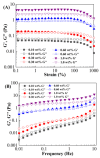Preparation and Properties of a Novel Multi-Functional Viscous Friction Reducer Suspension for Fracturing in Unconventional Reservoirs
- PMID: 40422364
- PMCID: PMC12110873
- DOI: 10.3390/gels11050344
Preparation and Properties of a Novel Multi-Functional Viscous Friction Reducer Suspension for Fracturing in Unconventional Reservoirs
Abstract
Aiming at the problem that conventional friction reducers used in fracturing cannot simultaneously possess properties such as temperature resistance, salt resistance, shear resistance, rapid dissolution, and low damage. Under the design concept of "medium-low molecular weight, salt-resistant functional monomer, supramolecular physical crosslinking aggregation, and enhanced chain mechanical strength", acrylamide, sulfonic acid salt-resistant monomer 2-acrylamide-2-methylpropanesulfonic acid, hydrophobic association monomer, and rigid skeleton functional monomer acryloyl morpholine were introduced into the friction reducer molecular chain by free radical polymerization, and combined with the compound suspension technology to develop a new type of multi-functional viscous friction reducer suspension (SAMD), the comprehensive performance of SAMD was investigated. The results indicated that the critical micelle concentration of SAMD was 0.33 wt%, SAMD could be dissolved in 80,000 mg/L brine within 3.0 min, and the viscosity loss of 0.5 wt% SAMD solution was 24.1% after 10 min of dissolution in 80,000 mg/L brine compared with that in deionized water, the drag reduction rate of 0.1 wt% SAMD solution could exceed 70% at 120 °C and still maintained good drag reduction performance in brine with a salinity of 100,000 mg/L. After three cycles of 170 s-1 and 1022 s-1 variable shear, the SAMD solution restored viscosity quickly and exhibited good shear resistance. The Tan δ (a parameter characterizing the viscoelasticity of the system) of 1.0 wt% SAMD solution was 0.52, which showed a good sand-carrying capacity, and the proppant settling velocity in it could be as low as 0.147 mm/s at 120 °C, achieving the function of high drag reduction at low concentrations and strong sand transportation at high concentrations. The viscosity of 1.4 wt% SAMD was 95.5 mPa s after shearing for 120 min at 140 °C and at 170 s-1. After breaking a gel, the SAMD solution system had a core permeability harm rate of less than 15%, while the SAMD solution also possessed the performance of enhancing oil recovery. Compared with common friction reducers, SAMD simultaneously possessed the properties of temperature resistance, salt resistance, shear resistance, rapid dissolution, low damage, and enhanced oil recovery. Therefore, the use of this multi-effect friction reducer is suitable for the development of unconventional oil reservoirs with a temperature lower than 140 °C and a salinity of less than 100,000 mg/L.
Keywords: friction reducer; high salinity; high temperature; low damage; shear resistance.
Conflict of interest statement
Jinsheng Sun is an employee of CNPC Engineering Technology R&D Company Limited. Shanbo Mu is an employee of Shandong Three Carbon Technology Development Co., Ltd. The remaining authors declare that the research was conducted in the absence of any commercial or financial relationships that could be construed as a potential conflict of interest.
Figures














Similar articles
-
Fracturing Fluid Polymer Thickener with Superior Temperature, Salt and Shear Resistance Properties from the Synergistic Effect of Double-Tail Hydrophobic Monomer and Nonionic Polymerizable Surfactant.Molecules. 2023 Jun 29;28(13):5104. doi: 10.3390/molecules28135104. Molecules. 2023. PMID: 37446764 Free PMC article.
-
Influence Factors of Multifunctional Viscous Drag Reducers and Their Optimization for Unconventional Oil and Gas Reservoirs.ACS Omega. 2021 Nov 15;6(47):32101-32108. doi: 10.1021/acsomega.1c04869. eCollection 2021 Nov 30. ACS Omega. 2021. PMID: 34870031 Free PMC article.
-
Experimental Investigation and Performance Evaluation of Modified Viscoelastic Surfactant (VES) as a New Thickening Fracturing Fluid.Polymers (Basel). 2020 Jun 30;12(7):1470. doi: 10.3390/polym12071470. Polymers (Basel). 2020. PMID: 32629958 Free PMC article.
-
A Review of Weak Gel Fracturing Fluids for Deep Shale Gas Reservoirs.Gels. 2024 May 18;10(5):345. doi: 10.3390/gels10050345. Gels. 2024. PMID: 38786262 Free PMC article. Review.
-
Chemical and Physical Architecture of Macromolecular Gels for Fracturing Fluid Applications in the Oil and Gas Industry; Current Status, Challenges, and Prospects.Gels. 2024 May 16;10(5):338. doi: 10.3390/gels10050338. Gels. 2024. PMID: 38786255 Free PMC article. Review.
References
-
- AL-Dogail A., Gajbhiye R., Patil S. A review of drag-reducing agents (DRAs) in petroleum industry. Arab. J. Sci. Eng. 2023;48:8287–8305. doi: 10.1007/s13369-022-07184-8. - DOI
-
- Wang P., Hu Y.H., Zhang L.Y., Meng Y., Ma Z.F., Wang T., Zhang Z., Fang J., Liu X., You Q., et al. Experimental study of the influencing factors and mechanisms of the pressure-reduction and augmented injection effect by nanoparticles in ultra-low permeability reservoirs. Pet. Sci. 2024;21:1915–1927. doi: 10.1016/j.petsci.2023.11.024. - DOI
-
- Chen X., Zhang G., Ding R., Zheng D., Yang Z., Sun Z., Zhou F., Wang D. Research on water blocking and residue damage mechanism of fracturing fluid in Yongjin tight reservoirs. Phys. Fluids. 2024;36:042018. doi: 10.1063/5.0205008. - DOI
-
- Qin L., Zhang X., Zhai C., Lin H., Lin S., Wang P., Li S. Advances in liquid nitrogen fracturing for unconventional oil and gas development: A review. Energy Fuels. 2022;36:2971–2992. doi: 10.1021/acs.energyfuels.2c00084. - DOI
-
- Jin L., Wan X., Azzolina N.A., Bosshart N.W., Zhao J., Yu Y., Smith S.A., Sorensen J.A., Gorecki C.D. Optimizing conformance control for gas injection EOR in unconventional reservoirs. Fuel. 2022;324:124523. doi: 10.1016/j.fuel.2022.124523. - DOI
Grants and funding
LinkOut - more resources
Full Text Sources

